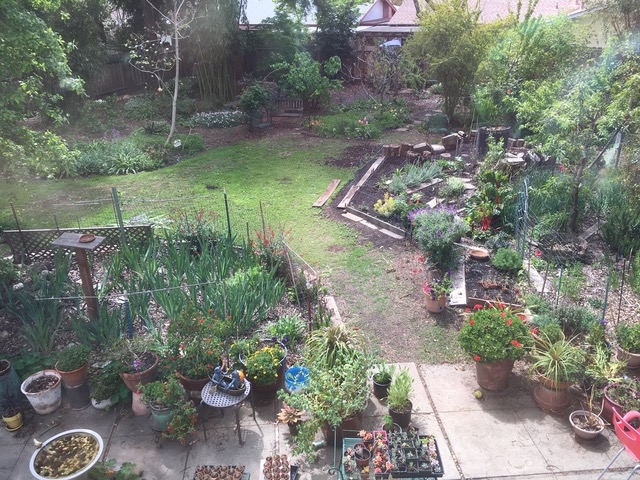by Rainer Hoenicke

Pathogen Mitigation Measures during the Pandemic
In anticipation of tomato season and my recently acquired knowledge of Fusarium and Verticillium wilt, I used the 2020 Coronavirus lock-down to think seriously about avoiding or at least mitigating my previous decade of tomato failure on my suburban lot. How ironic – while avoiding exposure to a new virus that is believed to have jumped the species barrier from bat to human, I am now also engaged in figuring out how to reduce exposure of my newly sprouted heirloom tomato seedlings and this spring's Master Gardener Tomato Sale specimens to a plant pathogen of a different sort – two soil-borne fungal species that are even more ubiquitous than the COVID-19 virus.
Cultural practices and selection of resistant tomato varieties seem to be the only means of mitigating these fungal diseases. Although my suburban lot is larger than most within the Napa city boundaries, it doesn't lend itself very well to rotational practices, since spots that receive more than six hours of sunlight each day are scarce, with all the big trees not only in my own yard but throughout the neighborhood. We are truly living in an urban forest with only a few clearings here and there.
So, I had to think creatively and take the time to strategically plan how to install the equivalent of a “Victory Garden” without a partial or complete tomato and pepper harvest failure. Here are the questions I asked myself:
1) Where do I get more than six hours of sun exposure in my yard?
2) Of those areas in my front and back yards, which have not contained vegetables in the nightshade family for at least the last five years?
3) What is growing there now, and is it worth re-purposing that area for growing tomatoes, peppers, potatoes, or eggplant?

Using cardboard for sheet mulching, topped generously with mulch acquired in February, while the yard waste composting facility was still open, has made removal of the Bermuda grass and other weeds in the backyard meadow relatively easy. The strips between rows of lavender, Ranunculus, Echinacea, and culinary sages are now looking forward to receiving a diverse mix of summer vegetables, and I am hoping for a tomato harvest beyond just a salad or two.
Informational links:
UC IPM-Fusarium https://vric.ucdavis.edu/pdf/diseases_fusariumwilt.pdf
Morton Arboretum-Verticillium
https://www.mortonarb.org/trees-plants/tree-and-plant-advice/help-diseases/verticillium-wilt
Univ of Wisconsin-both https://cdn.shopify.com/s/files/1/0145/8808/4272/files/A2617.pdf
UC ANR-Tomatoes https://ucanr.edu/sites/ucmgnevada/files/183442.pdf https://anrcatalog.ucanr.edu/pdf/8159.pdf
Sheet mulching
UCMG Marin County http://marinmg.ucanr.edu/Manage_A_Garden/Composting/Sheet_Mulching/
UCMG Contra Costa Co http://ccmg.ucanr.edu/files/221117.pdf
During Napa County's shelter in place directive that protects everyone's health and safety, Napa Master Gardeners are available to answer garden questions by email: mastergardeners@countyofnapa.org. or phone at 707-253-4143. Volunteers will get back to you after they research answers to your questions.
Visit our website: napamg.ucanr.edu to find answers to all of your horticultural questions.
Photo credits: Rainer Hoenicke
